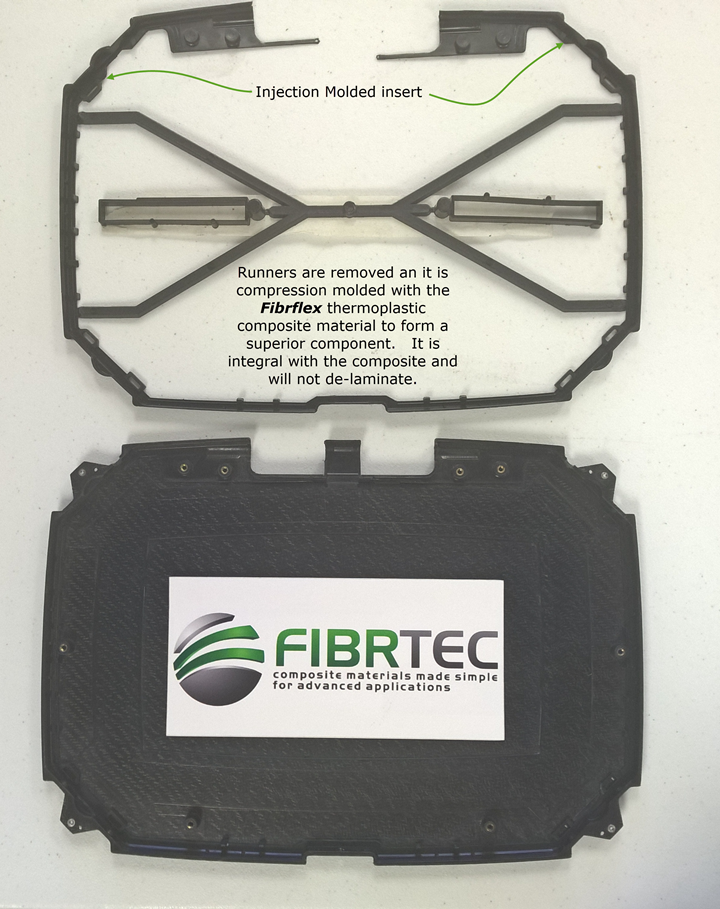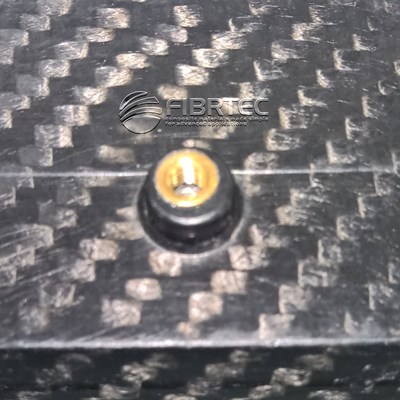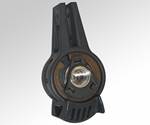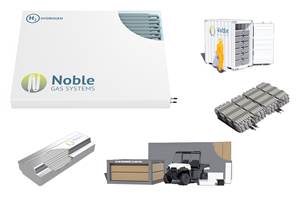Injection overmolding of unidirectional fibers and preforms is an attractive process for many good reasons. It’s fast, consistent and repeatable, and it can be performed with a machine that is relatively easy to acquire, program and control. Injection molding’s disadvantage, however, is it requires tooling that is typically very expensive — certainly more expensive than tools for compression molding. Further, overmolding requires that the composite be encapsulated within the tool, and if it’s a larger part, that means larger tooling. Add it all up and the cost of composites overmolding can exceed its benefits.
Robert Davies, CEO of Fibrtec (Atlanta, Texas, U.S.), has developed an interesting solution to this particular overmolding dilemma. His system uses a hybrid injection/compression overmolding process of his own design to combine smaller injection molded parts or inserts within a larger compression molded part. In essence, the approach flips the script on the overmolding strategy. Rather than injection mold around a composite preform, Davies’ solution involves compression molding around an injection molded part.
“What [Fibrtec] decided to do was injection mold the bosses, features, ribs and those kinds of things, and position them in place into the same compression molding tool that the laminate was going to be consolidated in,” says Mike Favaloro, president and CEO of composites consultancy CompositeTechs LLC (Amesbury, Mass., U.S.), who spoke about the process at the Composites Overmolding conference in Novi, Mich., U.S., in 2018.
“Since you have to consolidate the laminate anyway, why not consolidate the laminate with the injection molded parts in place?” he adds.
With Fibrtec’s process, ribs, bosses and similar features are injection molded off-line using thermoplastic resins, lower cost tooling and conventional injection molding machines. The injection molded insert is then robotically placed in a compression mold with a preform.

This laptop cover features an injection molded perimeter (top) that is consolidated with a preform made of Fibrtec’s Fibrflex thermoplastic carbon fiber towpreg in the compression mold to form the completed cover (bottom). Additional small features for another part of the laptop were formed in the center of the mold, making full use of the tool.
Source | Fibrtec
“You can make the inserts for the compression molded part fairly inexpensively and rapidly,” says Davies. “The key is putting the preform in the compression tool with inserted injection molded features.”
Fibrtec’s typical thermoplastic compression molding process uses a preform made of its Fibrflex thermoplastic towpreg and a heated compression mold. Fibrflex is comprised of resin-coated individual tows that are woven or braided, and then cut to the general shape of the tooling to form the preform.
For the injection/compression overmolding process, injection molded features are placed into holes or slots in the compression mold for precision indexing. The Fibrflex fabric preform is then placed into the mold, where it is heated to process temperature and pressure is applied. After a short time — seconds to minutes depending on the application — the part is cooled and ejected.

This screw boss insert was injection molded and then consolidated with the composite laminate during the compression molding stage.
Source | Fibrtec
“The inserts are made of the same resin that is in the composite, so when they’re melted and pressed together, they become homogeneous,” explains Davies.
When it comes to resin systems, Fibrtec has used polyetheretherketone (PEEK), polycarbonate/acrylonitrile butadiene styrene (PC/ABS) blend and polyamide (PA) 6 for the process.
Davies’ approach allows for the injection molding of these parts to be executed on a small, inexpensive machine at a fraction of the cost of larger more specialized injection molding machines that would be needed to enclose an entire composite assembly in order to overmold it. In addition, features such as bosses and ribs can be grouped in the injection molding tool, allowing for multiple parts to be created during each mold cycle either as multiples of the same part or as groups of parts. According to Davies, the smaller inserts can be injection molded several times a minute, whereas injection molding the whole part on a larger, special purpose machine could take several minutes for one part.
For larger parts, the process makes a lot of sense. The approach allows injection molding to be used for what it does best, namely making small, highly detailed, discrete features on small, inexpensive machinery. The actual overmolding occurs during the compression process in a way that takes advantage of what compression does best — consolidation.
Davies says he originally developed this process in 2008 using carbon fiber and PA 6 to create a laptop cover. The customer’s original design was for an all injection molded part, but a more durable cover was needed for tech service field work, which prompted Fibrtec’s compression overmolding solution. However, one of the caveats for the project was that the housing could not be reconfigured because of how the electronics were integrated within the part. The composites would have to be adapted to the original housing design and incorporate the injection molded features.
“The old adage applies — necessity is the mother of invention,” Davies quips.
For the laptop project, Fibrtec used a couple of molds for the injection molded features. One mold made several groups of parts, such as the screw bosses and other smaller features. The parts were cut from the runners and kitted for the composite compression molding operation later. Another mold was used for the perimeter portion of the back side of the LCD. The perimeter was molded in one piece with additional small features formed in the center portion of the mold, making full use of the tool. The additional features were cut from the runners and kitted prior to transferring to the compression molding operation. The injection molded inserts were then consolidated along with the laminate in the compression mold. The laptop is said to have successfully endured six-axis drop tests from up to 6 feet.
Fibrtec’s injection/compression composite overmolding process reportedly offers significant advantages over conventional injection overmolding, including reduced cycle time, reduced tooling cost, increased tailorability, reduced scrap and improved performance. Fibrtec also claims that the weld between the two materials is as good or better as can be accomplished with injection overmolding.
Additional advantages include the ability to put reinforcement selectively where it is needed, minimizing cost impact and reducing scrap. The injection mold runners can be left on the insert assembly after the injection molding step and can serve as additional material for the compression-overmolding step to create a “functional surface.” In other words, the runners can form ribs.
Fibrtec has gone on to use the process for military applications. For example, Davies says it was used to create a side cover for the XM25 Counter Defilade Target Engagement System (CDTE), a 25-millimeter grenade launcher used by the U.S. Army. PEEK was used for the composite matrix and for the inserts in the part. The company also used the process to create an improvised explosive device (IED) detector, using PA 6 for the resin system. A metal version of the handheld ground penetrating radar system weighed around 16 pounds, while Fibrtec’s injection/compression overmolding process yielded a 6-7-pound composite version.
While Fibrtec isn’t employing the process in any of its current projects, Davies hints that he might use it again, should the need arise.
“You do get a high-performing part,” he says. “The resin inserts and the composite do become homogeneous. You can make the inserts faster with this process, freeing the injection presses for other work. The compression molding can also be rapid, and the overall cost of tooling and capital expenditure can be less, perhaps ideal for intermediate volume applications. It all boils down to enabling design flexibility, lowering cost and increasing performance.”
Related Content
Corebon, Composite Braiding partner to enhance TPC manufacturing
Collaboration aims to overcome production limitations with tubular thermoplastic composites (TPC) by using induction-heated tooling and high-quality commingled braids.
Read MoreNoble Gas Systems 350-bar conformable pressure vessels pass HGV2 standard tests
Conformable tanks with new materials pass technical tests for hydrogen storage, to compete with Type IV pressure vessels using CFRP.
Read MoreCo-molding SMC with braided glass fiber demonstrates truck bed potential
Prepreg co-molding compound by IDI Composites International and A&P Technology enables new geometries and levels of strength and resiliency for automotive, mobility.
Read MoreRead Next
Overmolded hybrid parts open new composites markets
A process that combines continuous carbon fiber-reinforced PAEK with chopped fiber/PEEK overmolding is making inroads in the aerospace market. Parts that previously could not be produced cost-effectively from composites can now be made at less cost than their metal counterparts.
Read More“Structured air” TPS safeguards composite structures
Powered by an 85% air/15% pure polyimide aerogel, Blueshift’s novel material system protects structures during transient thermal events from -200°C to beyond 2400°C for rockets, battery boxes and more.
Read MoreVIDEO: High-volume processing for fiberglass components
Cannon Ergos, a company specializing in high-ton presses and equipment for composites fabrication and plastics processing, displayed automotive and industrial components at CAMX 2024.
Read More






















